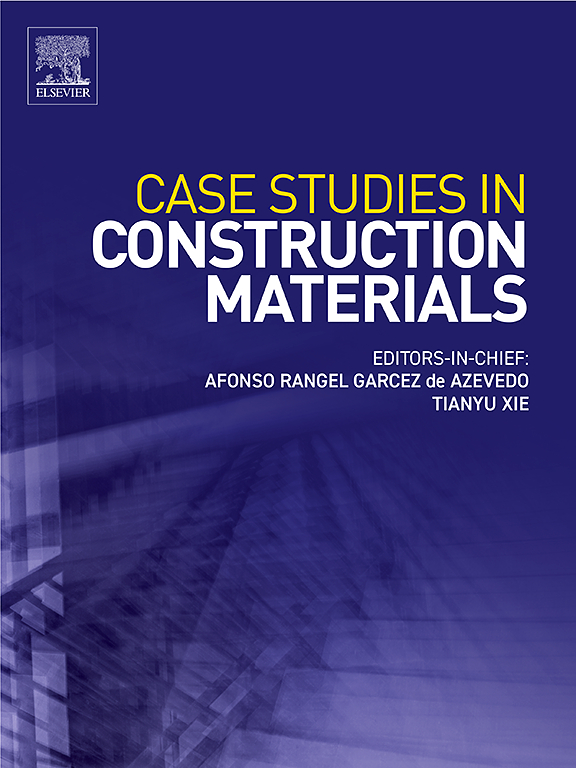模拟和比较分析可持续棉绳约束:全面与带状包裹增强混凝土强度和延性
IF 6.5
2区 工程技术
Q1 CONSTRUCTION & BUILDING TECHNOLOGY
引用次数: 0
摘要
天然frp作为合成frp的生态替代品的兴起,凸显了对使用棉绳进行部分约束的研究的必要性,因为棉绳具有高断裂应变的成本效益、低碳解决方案。与完全约束不同,通过棉绳条进行部分约束可以有效地加强老化的混凝土截面,减少材料的使用。尽管棉花对混凝土的局部约束具有许多优点,但尚未进行研究。本研究通过调查棉绳条的性能和开发分析模型来预测其结构影响,从而解决了这一差距。本研究测试了两种强度的圆柱形混凝土试件,分别采用棉绳完全包裹加固(组1)和带状包裹加固(组2)。每组按混凝土强度进一步划分,包括1个未加固试件和3个采用一层、两层或三层棉绳加固的试件。试验结果表明,棉绳包裹层有效约束了混凝土,提高了混凝土的承载能力,使混凝土的极限抗压强度提高9.97 ~ 152.10 %,极限应变提高188.00 % ~ 1488.89 %。压应力与应变的关系表现为最初的刚性弹性上升,然后是抛物线过渡。第二个分支的反应,上升或下降,是显著改善与增加约束比。在压应力-应变曲线上,ⅰ型破坏表现为上升的第二分支,ⅱ型破坏表现为下降的第二分支。4个试件表现为i型破坏(L-2F、L-3F、H-3F和L-3S),主要是全构型破坏,无侧限抗压强度较低。第二个分支的模量随着约束比的增加而提高,在约束比约为0.50时从ii型破坏过渡到i型破坏。回归分析得到了沿压缩响应方向各关键点的方程,其R²值大于0.90,表明其与约束比有很强的相关性。Popovics模型有效地预测了第一部分压缩响应,预测曲线与实验结果吻合较好。本文章由计算机程序翻译,如有差异,请以英文原文为准。
Modeling and comparative analysis of sustainable cotton rope confinement: Full vs. STrip wrapping for enhanced concrete strength and ductility
The rise of natural FRPs as ecological alternatives to synthetic ones has highlighted the need for studies on partial confinement using cotton ropes, which offer cost-effective, low-carbon solutions with high rupture strain. Unlike full confinement, partial confinement through cotton rope strips can efficiently strengthen deteriorated concrete sections with reduced material usage. Despite possessing several advantages, the partial confinement by cotton on concrete has not been investigated. This study addresses the gap by investigating the performance of cotton rope strips and developing analytical models to predict their structural impact. This study tested cylindrical concrete specimens of two strengths, strengthened with cotton rope in either complete wrapping (Group 1) or strip wrapping (Group 2). Each group was further divided by concrete strength and included one unstrengthened specimen, and three strengthened with one, two, or three layers of cotton rope. Experimental results revealed that cotton rope wraps effectively confined the concrete, enhancing load-bearing capacity and improving ultimate compressive strength by 9.97–152.10 % and ultimate strain by 188.00 % to 1488.89 %. The compressive stress vs. strain behavior exhibited an initial stiff elastic ascent followed by a parabolic transition. The second branch of the response, either ascending or descending, was significantly improved with an increased confinement ratio. Type-I failure was characterized by an ascending second branch in the compressive stress vs. strain curve, while Type-II failure exhibited a descending second branch. Four specimens demonstrated Type-I failure (L-2F, L-3F, H-3F, and L-3S), predominantly in full configurations and with lower unconfined compressive strength. The modulus of the second branch improved with an increased confinement ratio, transitioning from Type-II to Type-I failure near a ratio of approximately 0.50. Regression analysis provided equations of various key points along the compressive response with R² values greater than 0.90, highlighting a strong dependence on the confinement ratio. The Popovics model effectively predicted the first part of the compressive response, with predicted curves closely matching experimental results.
求助全文
通过发布文献求助,成功后即可免费获取论文全文。
去求助
来源期刊

Case Studies in Construction Materials
Multiple-
CiteScore
7.60
自引率
19.40%
发文量
842
审稿时长
63 days
期刊介绍:
Case Studies in Construction Materials provides a forum for the rapid publication of short, structured Case Studies on construction materials. In addition, the journal also publishes related Short Communications, Full length research article and Comprehensive review papers (by invitation).
The journal will provide an essential compendium of case studies for practicing engineers, designers, researchers and other practitioners who are interested in all aspects construction materials. The journal will publish new and novel case studies, but will also provide a forum for the publication of high quality descriptions of classic construction material problems and solutions.
 求助内容:
求助内容: 应助结果提醒方式:
应助结果提醒方式:


